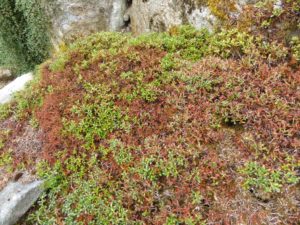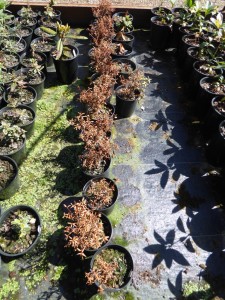August 27, 2015

Today’s discussion covers two topics although they are closely intertwined with one other. For the first portion, those of us in the Mediterranean climate of the Pacific NW have thoroughly enjoyed/ suffered through what people will either say was the greatest or worst summer ever. This depends of course on whether you are looking at it from the point of view of days spent at the beach vs. days spent trying to keep monsoon-climate plants alive. In reality, following an incredibly dry and warm spring with winter precipitation and snow-pack at record low levels, we zoomed straight into summer in mid-May – about six weeks ahead of schedule (it is typically quite cool and rainy right on through the Fourth of July holidays). It has turned out to be the hottest and driest June on record followed by the same for July (this after the July record was broken last year!). August is following the same path but we have yet to see the final tally. End result – massive amounts of watering and massive die-off of struggling plants – including native trees and shrubs on road margins, etc.

The second topic concerns the lack of certain species in our twice yearly catalogs. Certain choice and rare species – especially the highly coveted dwarf and alpine species such as pumilum, sargentianum, etc., can be very difficult to keep alive in the garden, let alone propagate and grow on to a saleable size. For one thing, these challenging species can be very slow-growing (read as very little extension growth) which means that it can be difficult to get any reasonable amount of cuttings. Plus, these species tend to be hard to root anyway (I am talking the true species not hybrids masquerading under an assumed name). So, let’s say Dennis has managed to find 35 cuttings on R. sargentianum 1977/721, a year later 20 of these have rooted and have been pulled from the cutting bench and potted up. Within two years, they are ready for transplanting into gallon containers but five have died in the interim (for various, often unknown reasons, it is a tricky species). Transplanting results in the loss of another five. Two years later the ten survivors are looking beautiful and are large enough to sell and ship. In June, before the heat hits (in a normal year) I am doing inventory in the hoops putting the fall distribution catalog together. I note 10 sargentianum 1977/721 and enter it into the catalog, description, price, etc. In July of any given year we get our first stretch of hot weather and blam! Ten dead sargentianum. This is but one of the reasons you do not find this species offered very often. Why did the ten plants not die until the year they were offered? There are many reasons for this including their very slow-growth resulting in the breakdown of the media in the container (not a problem in a plant that fills out a pot in two years) which leads to root problems; plants have been moved into a sunnier (hotter) location once potted up (the young plants are in band pots in the shady part of the nursery), etc. etc.
This year of course, we have had a tremendous amount of die-off from the early and non-stop, record-breaking heat including the entire crop of four-year old R. sargentianum which would have easily sold out in the catalog. The life of a rhododendron farmer.
